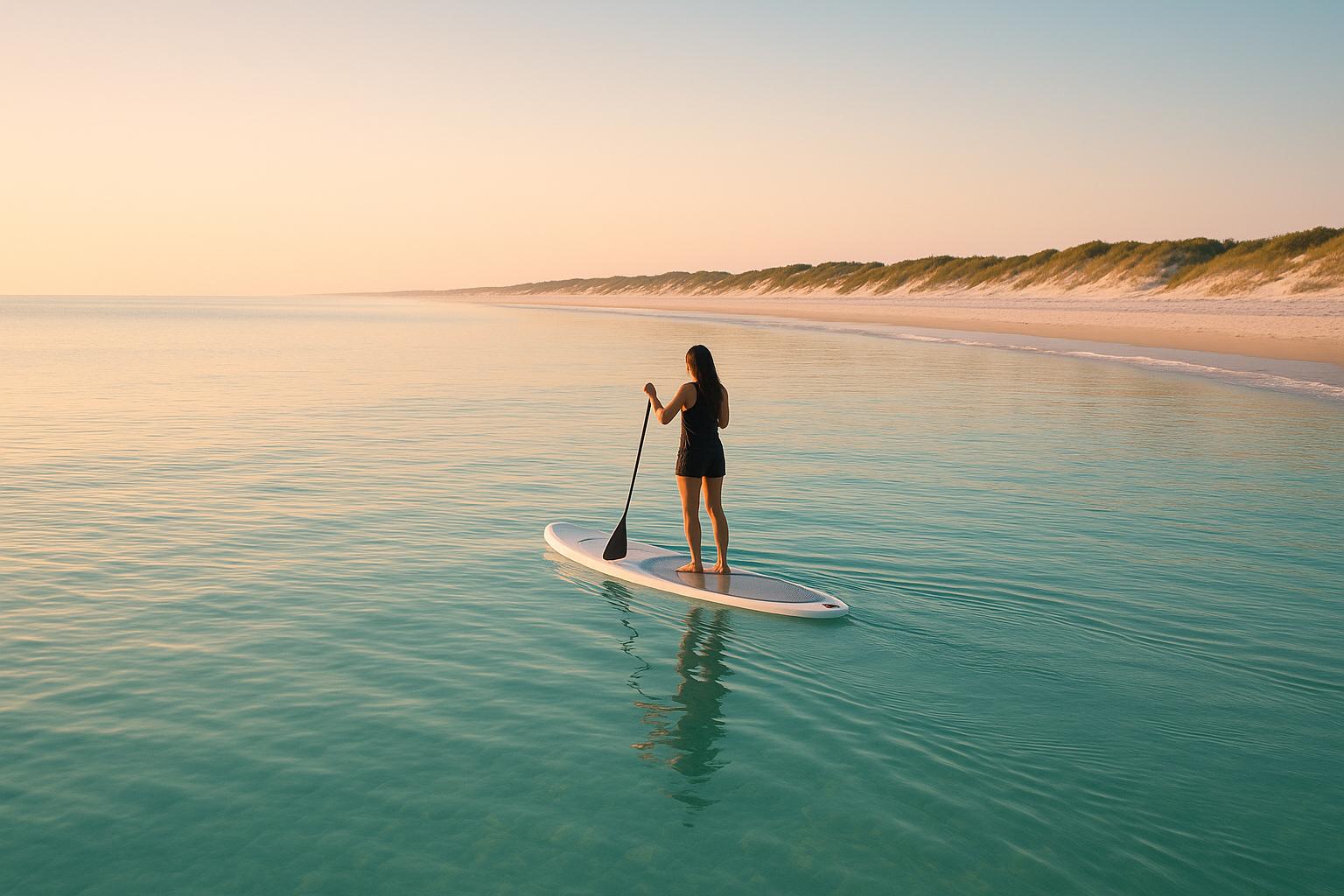When deciding between public and private beach access along Florida's 30A, your choice depends on your family's needs, budget, and preferences. Public beaches are free and offer flexibility, with amenities like restrooms and lifeguards at larger access points. However, they can be crowded, especially during peak times. Private beach access, tied to resorts or rentals, provides more privacy, convenience, and premium perks but comes at an added cost.
Key Points to Consider:
- Public Access: Free, larger crowds, lifeguards, and basic facilities like restrooms and parking (limited in some areas).
- Private Access: Costs included in rentals/resorts, fewer crowds, closer proximity to accommodations, and premium amenities like chairs and umbrellas.
- Legal Considerations: Some areas face disputes over "customary use" rights, so stick to well-marked public access points.
Quick Tip: Combine both options - stay at a property with private access for convenience and explore public beaches for variety and a lively atmosphere.
Florida Public Beaches are Private Now? WATCH THIS
Public Beach Access on 30A

Public beach access along the 30A corridor provides an affordable way to enjoy Florida's stunning coastline. Walton County boasts over 50 beach and bay access points across its 26 miles of shoreline, offering families plenty of choices to find their ideal spot. These access points range from fully equipped facilities with amenities to simple pathways leading straight to the sand.
Here’s a closer look at the main public access options available on 30A.
Types of Public Beach Access
There are four main types of public beach access along 30A:
- Regional Beach Access Points: Walton County operates nine full-service Regional Beach Access points. These locations are perfect for a complete beach day, featuring amenities like large parking areas, clean restrooms, outdoor showers, and wheelchair accessibility. Popular spots include Inlet Beach, Seagrove Beach, and Seaside.
- Neighborhood Beach Access Points: With 47 smaller access points, these are designed for pedestrians and offer a quieter, more low-key experience. Services are minimal, making them ideal for those who don’t need extra facilities.
- State Park Beach Access: Walton County's four state parks provide access to the Gulf of Mexico, with three offering beach access. These parks create a more secluded beach experience, surrounded by natural beauty.
- Bay & Lake Access Points: These access points cater to water activities, with boat ramps and access to coastal dune lakes and Choctawhatchee Bay. Some locations also feature playgrounds, making them great for families looking for a mix of beach and water-based fun.
Benefits for Families
Public beach access is a budget-friendly option that lets families bring their own gear, such as umbrellas, chairs, and coolers. It also allows visitors to choose from independent vendors for added flexibility.
Safety is a key focus at Regional Beach Access points. Lifeguards are on duty from March to October, and Inlet Beach even offers limited lifeguard coverage year-round.
Potential Drawbacks
Neighborhood Beach Access points, while convenient for walk-up visitors, often lack extensive parking and amenities. Families needing restrooms or outdoor showers might find Regional Beach Access points more suitable for their needs.
These features highlight the convenience and flexibility of public beach access, offering a strong alternative to private options, which come with their own set of advantages and limitations.
Private Beach Access on 30A
Private beach access along 30A is often tied to vacation rental homes, resorts, or gated communities. It gives families a more peaceful and intimate beach experience compared to the busier public access points.
Why It’s Great for Families
Having private beach access means more convenience and a lot more privacy. Families can enjoy uninterrupted time by the water without dealing with the hustle and bustle of crowded public areas. Plus, it’s easy to head back to your rental or resort for a quick break, making the day more relaxed and enjoyable. This level of exclusivity offers a completely different vibe compared to public beach access, setting the two experiences worlds apart.
Public vs. Private Beach Access: Side-by-Side Comparison
When deciding between public and private beach access on 30A, it’s important to weigh the pros and cons of each option. Both offer unique benefits and trade-offs that can shape your beach experience. Here's a closer look at what sets them apart.
Public beaches are free to access, while private beaches often come with fees, either as part of a rental or resort package.
The level of privacy is another key difference. Public beaches tend to attract larger crowds, especially during peak seasons and holidays, making them lively but less secluded. In contrast, private beaches offer a quieter, more exclusive atmosphere where your family can enjoy the sand and waves with fewer strangers nearby.
Amenities and convenience also vary. Public beaches typically provide basic facilities like restrooms and outdoor showers, and parking often requires a short walk. Private beach access, however, usually includes premium perks like beach chairs, umbrellas, and closer proximity to your accommodation, making those quick trips for snacks or sunscreen much easier.
The table below highlights the main differences to help you decide:
Comparison Table: Key Factors
| Factor | Public Beach Access | Private Beach Access |
|---|---|---|
| Cost | Free | Fees included in rental/resort charges |
| Parking | Limited spaces; may involve walking | Dedicated parking or close access |
| Crowds | Larger crowds, especially on weekends | Fewer people, more privacy |
| Amenities | Basic (restrooms, showers) | Premium (chairs, umbrellas, concierge services) |
| Flexibility | Access to various beach areas | Limited to specific property or resort |
| Beach Space | Shared with the public | Exclusive or semi-exclusive areas |
| Safety Oversight | Lifeguards at some locations | Private staff or security monitoring |
| Food Options | Bring your own or visit nearby eateries | Room service or on-site dining available |
When it comes to flexibility, public beaches give you the freedom to explore multiple spots along 30A, offering opportunities to discover new areas, try different restaurants, and soak in the vibrant local culture. Private beaches, on the other hand, limit you to the stretch of sand tied to your rental or resort, but guarantee a consistent level of quality and available space.
Safety is another consideration. Public beaches often have lifeguards on duty during busy seasons, providing professional oversight for swimmers. Private beaches might feel more secure due to fewer strangers, but professional lifeguard services are less common, with safety often managed by private staff or security teams.
Ultimately, the choice between public and private beach access depends on your family’s priorities - whether it’s affordability and flexibility or privacy and convenience.
sbb-itb-d06eda6
Beach Access Laws and Customary Use Issues
Beach access along 30A in South Walton County has become a tricky legal topic, shaping where families can enjoy the coastline. The main question revolves around whether the public can continue using privately owned beachfront areas based on long-standing traditions.
To grasp the issue, it's important to understand Florida's property rules. In the state, the land below the mean high-water line is considered public, while the dry sand above it is usually privately owned. This creates a patchwork of ownership along 30A, with some areas clearly open to the public and others falling into a legal gray zone.
In recent years, tensions have grown as some beachfront property owners have blocked access to areas that locals and visitors have historically used freely. Property owners often argue that they have the right to protect their private investments, while residents and local leaders emphasize the need to uphold community customs of open access.
The concept of customary use plays a significant role here. Under this legal principle, the public can access private property if they can prove consistent, long-term use over time. However, proving this kind of historical use is no small task, especially as development along 30A has surged in recent years.
Local officials have been working to establish these customary use rights by digging through historical records and other evidence to document public usage patterns. This process means that even neighboring stretches of beach might have different rules about access. For families, this legal uncertainty can make planning a beach outing more complicated, as areas once open to the public may now display "No Trespassing" signs or be blocked off by fences or other barriers.
Law enforcement also finds itself in a tough spot, tasked with deciding whether someone is on public land or trespassing on private property. The distinction is often subtle and can lead to conflicts. Beyond property rights, this issue carries economic weight, too. Tourism is a cornerstone of South Walton's economy, and limiting beach access could make the area less attractive to visitors.
Recent legislative efforts aim to clarify these access laws and ensure that public entry points remain available. For now, families are advised to stick to well-marked public access points and beaches that are clearly designated for public use. These spots generally offer the amenities needed for a stress-free day at the beach.
The broader debate over customary use highlights the ongoing struggle between rapid development and the community's desire to keep coastal spaces accessible - a challenge shared by many coastal areas in Florida. By understanding these legal complexities, families can better navigate their options and make informed choices about where to enjoy their time on the beach.
How to Choose the Right Beach Access for Your Family
Choosing the right beach access for your family involves more than just picking a convenient location. It’s about finding the perfect balance between your budget, family needs, privacy preferences, and the kind of beach experience you’re aiming for. Here are some key factors to guide your decision.
Budget is often the first thing to consider. Public beaches usually come with little to no cost, making them an affordable option. On the other hand, private beach access - often tied to vacation rentals or resorts - can add to your overall expenses. That said, private options frequently include perks like beach chairs, umbrellas, and restroom facilities, which can save you the hassle of bringing your own.
Your family’s composition and mobility needs also play a big role. If your group includes toddlers or elderly family members, having closer parking and shorter walks to the sand might be essential. In these cases, private access could be more convenient.
Privacy is another important factor. If your family enjoys a quieter, less crowded setting - especially for teenagers who might want space to play or relax - private beaches can provide that extra room. On the flip side, public beaches often offer a lively, social atmosphere that some families might prefer.
Flexibility in your schedule can also influence your choice. Families with flexible timing can visit public beaches during off-peak hours to avoid crowds, while those with fixed schedules or young kids who need regular nap times might appreciate the ease and predictability of private access.
Your preferred activities should guide your decision as well. Public beaches are often packed with options like water sports rentals, beach volleyball, and other organized activities. Meanwhile, private beaches are better suited for families seeking peaceful relaxation or quiet bonding time.
As mentioned earlier, legal access considerations are worth keeping in mind. Opting for clearly marked public access points, such as state parks, can help you steer clear of disputes over customary use areas. These locations often provide reliable access and clear guidelines.
Weather backup plans are another detail to think about. Many private beach accommodations include indoor amenities like pools, game rooms, or covered spaces, offering alternatives during bad weather. Public beachgoers, however, might need to plan ahead, as facilities may close during storms. Local insights can also help you prepare for unexpected weather changes.
For families who visit the 30A area frequently, resources like sowal.co can be invaluable. They provide updates on beach conditions, access changes, and even lesser-known spots, helping you strike a balance between crowded tourist areas and more exclusive private options.
Finally, consider transportation and trip length. If you’re staying for a short visit or don’t have access to a car, private beach access might be more convenient. For longer stays, public beaches can offer greater flexibility and cost savings.
A smart approach is to book accommodations with private beach access for convenience while also exploring public beaches for variety and local charm. This way, you can enjoy the security of guaranteed access while discovering new coastal gems along the 30A corridor. Tailor your choice to your family’s specific needs, and you’ll create a beach experience everyone will love.
Conclusion: Making the Right Choice for Your Family
As you wrap up your plans, keep these essential points in mind to create the perfect beach getaway for your family.
When deciding between public and private beach access on 30A, think about your family's budget, desired level of privacy, ease of access, and the amenities you value most. Each option has something unique to offer.
A great strategy is to combine the best of both worlds. Many families opt for accommodations with private beach access for guaranteed convenience and then venture out to public beaches for a change of scenery. Public beaches offer a chance to explore new areas and soak in the lively, welcoming vibe that makes 30A so special.
Preparation is everything. Resources like sowal.co can be incredibly helpful, providing up-to-date information on beach conditions, access points, local events, and even hidden treasures along the coastline. Take advantage of tools like live beach cams, event listings, and dining recommendations to make the most of your trip.
Stay flexible. Weather, moods, or unexpected discoveries can change your plans, and that's okay. Knowing your options - whether it's a secluded private spot or a vibrant public beach - gives you the freedom to adjust and enjoy each day to its fullest.
The key to an unforgettable 30A beach experience lies in choosing the right mix of access options to suit your family's needs.
FAQs
How do disputes over 'customary use' impact my family's ability to access beaches along 30A?
Conflicts over 'customary use' rights along 30A have sparked debates between private property owners and the public about who can access certain beach areas. These rights stem from the public's long history of using privately owned beaches for activities like strolling, sunbathing, and swimming.
While recent legal changes and court decisions have attempted to define these rights, property owners still have the option to contest them in court. This means access to some beaches could be limited, depending on how these disputes or local laws evolve. If you're planning a trip to 30A, it's a good idea to stay informed and check for the latest updates on beach access before you go.
How can families find the right balance between cost and convenience when choosing between public and private beach access?
Families can find the right balance by weighing their priorities. Public beaches are often free or come with a small fee, offering easy access and amenities that make them a budget-friendly choice. The downside? They can get pretty packed, especially during peak seasons. On the other hand, private beaches usually involve a fee or rental but provide a quieter, more exclusive atmosphere - an option worth considering if a peaceful day by the water is a top priority.
To get the most out of public beaches, try visiting during off-peak hours or look into local programs that highlight less crowded or hidden spots. For private beaches, day passes or vacation rentals with shared access can give you that exclusive feel without breaking the bank. With some thoughtful planning, families can enjoy the perks of both options while staying on budget.
What can I do to make sure my family has a safe and fun trip to public beaches on 30A during busy times?
Heading to public beaches on 30A during peak seasons? A little planning can go a long way in making your family’s visit both safe and enjoyable. Start by arriving early to grab a prime spot and consider setting up near lifeguard stations for added peace of mind. Pay attention to the beach flag warning system, which provides important safety information, and keep a close watch on kids, especially in busy areas or near the water.
Don’t forget to pack the essentials: sunscreen to protect against sunburn, plenty of water to stay hydrated, snacks to keep energy levels up, and some shade options like umbrellas or beach tents for comfort. It’s also a good idea to teach your family about rip currents and what to do if they encounter one. And above all, always keep an eye on children when they’re near the water. A little preparation can turn a simple beach day into a fun and stress-free memory for everyone!



